Synovate Research Company: Learning and Development Project
VerifiedAdded on 2019/09/20
|29
|7464
|91
Project
AI Summary
This project is a research proposal focusing on the impact of human resource learning and development initiatives on organizational change within a mid-sized organization in the UAE, specifically Synovate Research Company. The research aims to determine the impact of learning and development initiatives on organizational performance. The project includes a problem statement, research objectives, a literature review covering various studies on training and development, identification of independent and dependent variables, hypothesis formulation, research questions, and a detailed research methodology. The methodology includes data collection procedures using quantitative methods with close-ended questions and survey questionnaires, data analysis using MS Excel, and a sampling strategy employing convenient sampling with 100 respondents. The project also provides recommendations based on the research findings and concludes with a summary of the key insights. The project is divided into three tasks, with the first task covering the research proposal, the second task presenting an executive summary with case evaluations, and the third task comparing qualitative, quantitative, and experimental research methods.

Portfolio
Paraphrase This Document
Need a fresh take? Get an instant paraphrase of this document with our AI Paraphraser
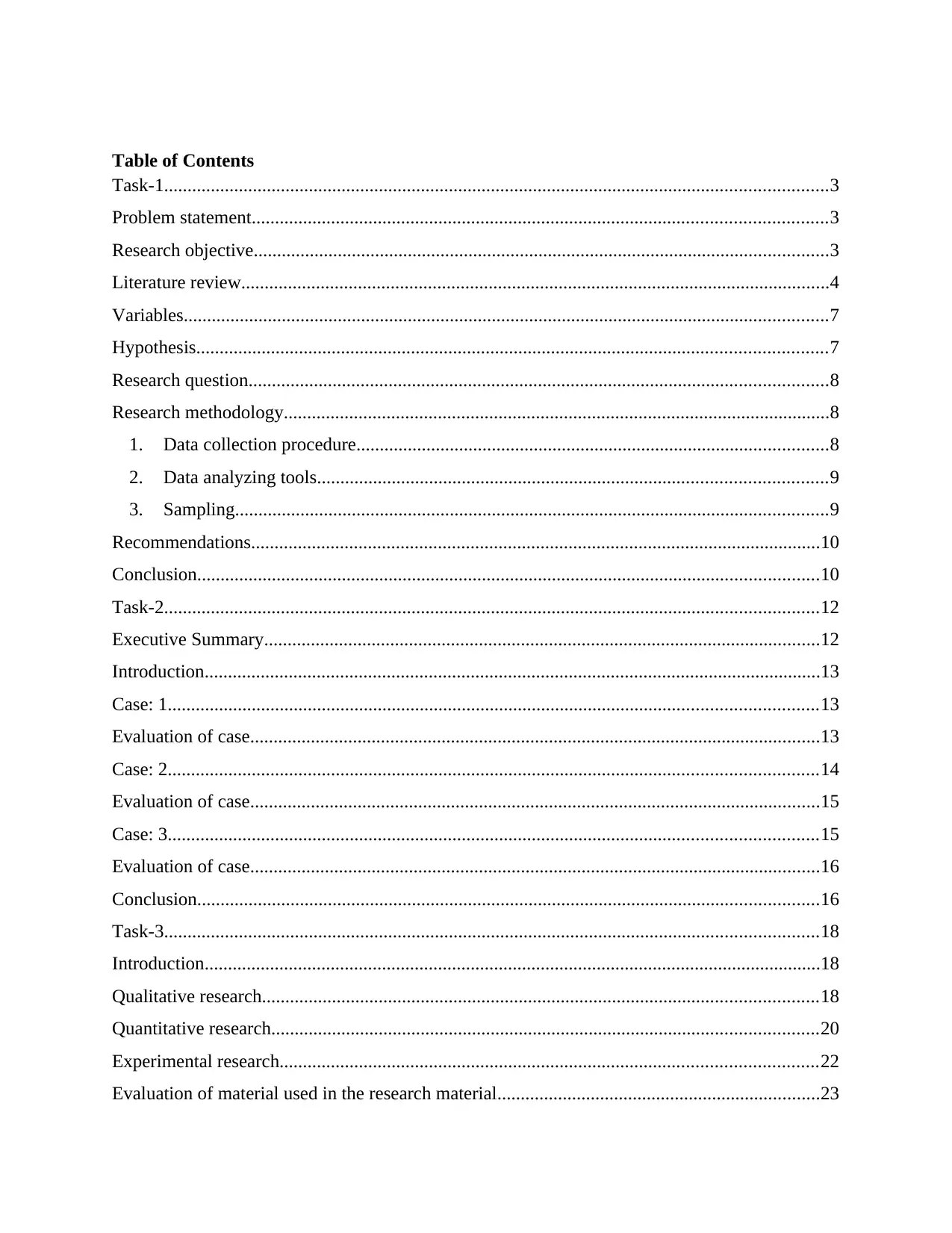
Table of Contents
Task-1..............................................................................................................................................3
Problem statement...........................................................................................................................3
Research objective...........................................................................................................................3
Literature review..............................................................................................................................4
Variables..........................................................................................................................................7
Hypothesis.......................................................................................................................................7
Research question............................................................................................................................8
Research methodology.....................................................................................................................8
1. Data collection procedure.....................................................................................................8
2. Data analyzing tools.............................................................................................................9
3. Sampling...............................................................................................................................9
Recommendations..........................................................................................................................10
Conclusion.....................................................................................................................................10
Task-2............................................................................................................................................12
Executive Summary.......................................................................................................................12
Introduction....................................................................................................................................13
Case: 1...........................................................................................................................................13
Evaluation of case..........................................................................................................................13
Case: 2...........................................................................................................................................14
Evaluation of case..........................................................................................................................15
Case: 3...........................................................................................................................................15
Evaluation of case..........................................................................................................................16
Conclusion.....................................................................................................................................16
Task-3............................................................................................................................................18
Introduction....................................................................................................................................18
Qualitative research.......................................................................................................................18
Quantitative research.....................................................................................................................20
Experimental research...................................................................................................................22
Evaluation of material used in the research material.....................................................................23
Task-1..............................................................................................................................................3
Problem statement...........................................................................................................................3
Research objective...........................................................................................................................3
Literature review..............................................................................................................................4
Variables..........................................................................................................................................7
Hypothesis.......................................................................................................................................7
Research question............................................................................................................................8
Research methodology.....................................................................................................................8
1. Data collection procedure.....................................................................................................8
2. Data analyzing tools.............................................................................................................9
3. Sampling...............................................................................................................................9
Recommendations..........................................................................................................................10
Conclusion.....................................................................................................................................10
Task-2............................................................................................................................................12
Executive Summary.......................................................................................................................12
Introduction....................................................................................................................................13
Case: 1...........................................................................................................................................13
Evaluation of case..........................................................................................................................13
Case: 2...........................................................................................................................................14
Evaluation of case..........................................................................................................................15
Case: 3...........................................................................................................................................15
Evaluation of case..........................................................................................................................16
Conclusion.....................................................................................................................................16
Task-3............................................................................................................................................18
Introduction....................................................................................................................................18
Qualitative research.......................................................................................................................18
Quantitative research.....................................................................................................................20
Experimental research...................................................................................................................22
Evaluation of material used in the research material.....................................................................23

Recommendation...........................................................................................................................24
Conclusion.....................................................................................................................................25
References......................................................................................................................................26
Conclusion.....................................................................................................................................25
References......................................................................................................................................26
⊘ This is a preview!⊘
Do you want full access?
Subscribe today to unlock all pages.

Trusted by 1+ million students worldwide
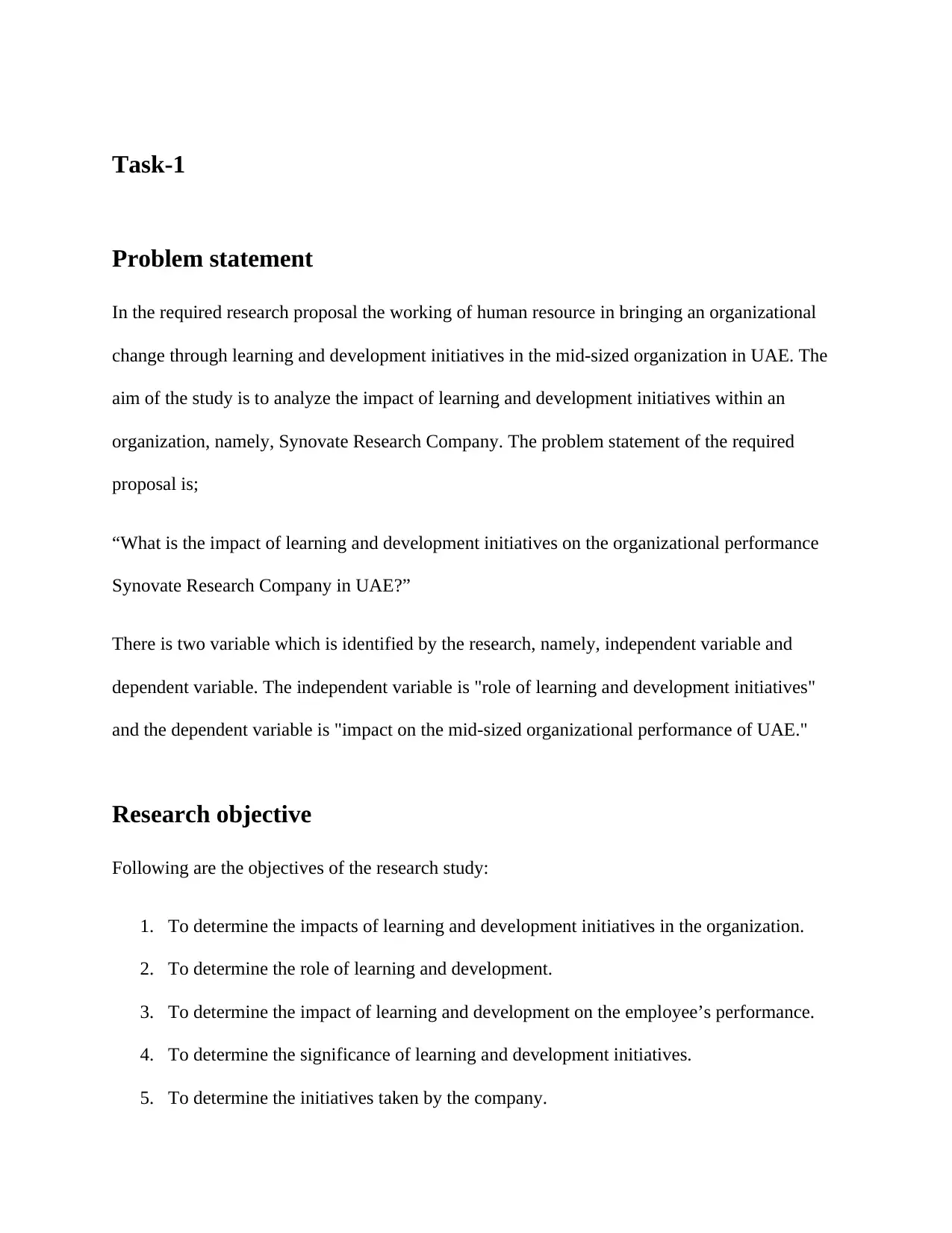
Task-1
Problem statement
In the required research proposal the working of human resource in bringing an organizational
change through learning and development initiatives in the mid-sized organization in UAE. The
aim of the study is to analyze the impact of learning and development initiatives within an
organization, namely, Synovate Research Company. The problem statement of the required
proposal is;
“What is the impact of learning and development initiatives on the organizational performance
Synovate Research Company in UAE?”
There is two variable which is identified by the research, namely, independent variable and
dependent variable. The independent variable is "role of learning and development initiatives"
and the dependent variable is "impact on the mid-sized organizational performance of UAE."
Research objective
Following are the objectives of the research study:
1. To determine the impacts of learning and development initiatives in the organization.
2. To determine the role of learning and development.
3. To determine the impact of learning and development on the employee’s performance.
4. To determine the significance of learning and development initiatives.
5. To determine the initiatives taken by the company.
Problem statement
In the required research proposal the working of human resource in bringing an organizational
change through learning and development initiatives in the mid-sized organization in UAE. The
aim of the study is to analyze the impact of learning and development initiatives within an
organization, namely, Synovate Research Company. The problem statement of the required
proposal is;
“What is the impact of learning and development initiatives on the organizational performance
Synovate Research Company in UAE?”
There is two variable which is identified by the research, namely, independent variable and
dependent variable. The independent variable is "role of learning and development initiatives"
and the dependent variable is "impact on the mid-sized organizational performance of UAE."
Research objective
Following are the objectives of the research study:
1. To determine the impacts of learning and development initiatives in the organization.
2. To determine the role of learning and development.
3. To determine the impact of learning and development on the employee’s performance.
4. To determine the significance of learning and development initiatives.
5. To determine the initiatives taken by the company.
Paraphrase This Document
Need a fresh take? Get an instant paraphrase of this document with our AI Paraphraser
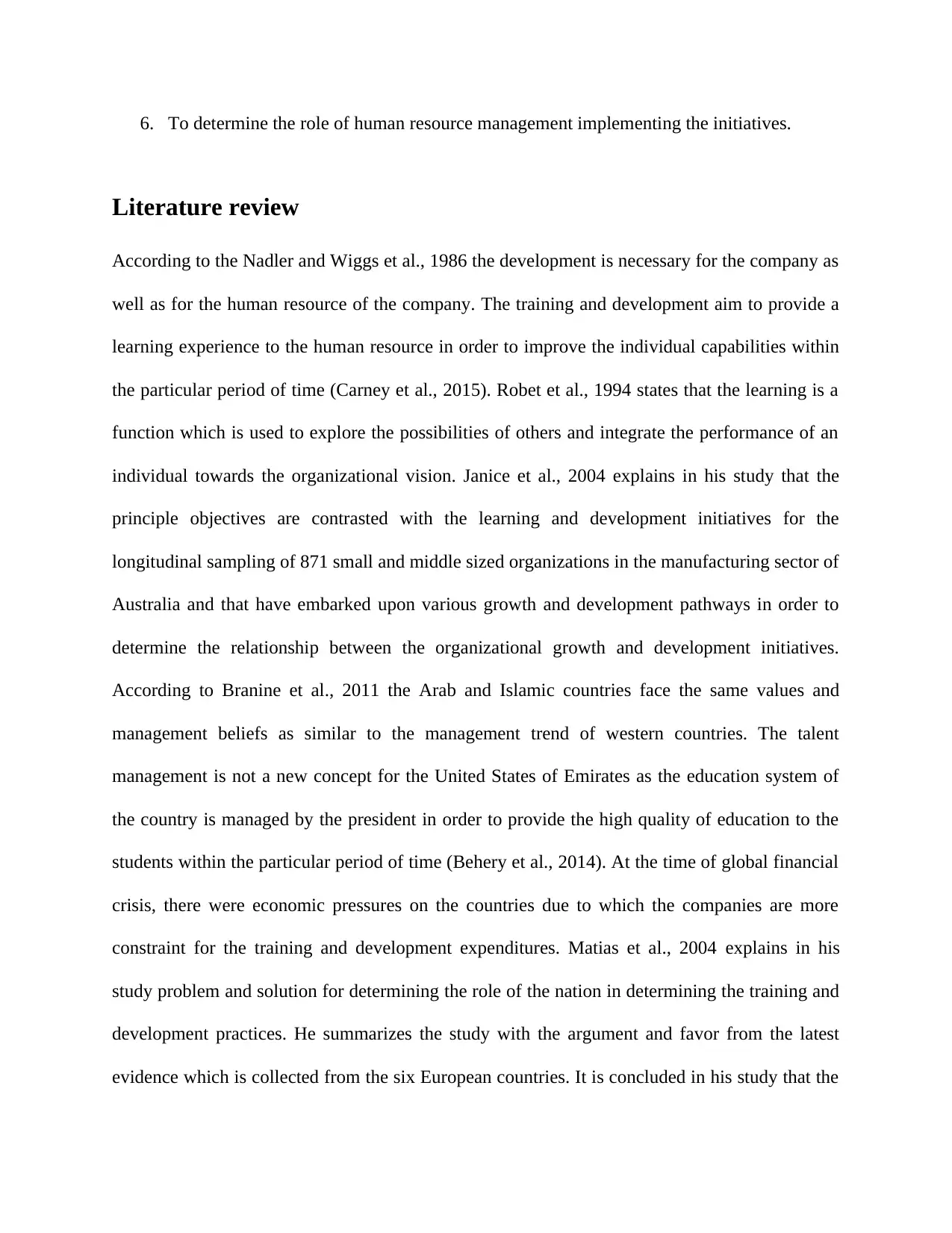
6. To determine the role of human resource management implementing the initiatives.
Literature review
According to the Nadler and Wiggs et al., 1986 the development is necessary for the company as
well as for the human resource of the company. The training and development aim to provide a
learning experience to the human resource in order to improve the individual capabilities within
the particular period of time (Carney et al., 2015). Robet et al., 1994 states that the learning is a
function which is used to explore the possibilities of others and integrate the performance of an
individual towards the organizational vision. Janice et al., 2004 explains in his study that the
principle objectives are contrasted with the learning and development initiatives for the
longitudinal sampling of 871 small and middle sized organizations in the manufacturing sector of
Australia and that have embarked upon various growth and development pathways in order to
determine the relationship between the organizational growth and development initiatives.
According to Branine et al., 2011 the Arab and Islamic countries face the same values and
management beliefs as similar to the management trend of western countries. The talent
management is not a new concept for the United States of Emirates as the education system of
the country is managed by the president in order to provide the high quality of education to the
students within the particular period of time (Behery et al., 2014). At the time of global financial
crisis, there were economic pressures on the countries due to which the companies are more
constraint for the training and development expenditures. Matias et al., 2004 explains in his
study problem and solution for determining the role of the nation in determining the training and
development practices. He summarizes the study with the argument and favor from the latest
evidence which is collected from the six European countries. It is concluded in his study that the
Literature review
According to the Nadler and Wiggs et al., 1986 the development is necessary for the company as
well as for the human resource of the company. The training and development aim to provide a
learning experience to the human resource in order to improve the individual capabilities within
the particular period of time (Carney et al., 2015). Robet et al., 1994 states that the learning is a
function which is used to explore the possibilities of others and integrate the performance of an
individual towards the organizational vision. Janice et al., 2004 explains in his study that the
principle objectives are contrasted with the learning and development initiatives for the
longitudinal sampling of 871 small and middle sized organizations in the manufacturing sector of
Australia and that have embarked upon various growth and development pathways in order to
determine the relationship between the organizational growth and development initiatives.
According to Branine et al., 2011 the Arab and Islamic countries face the same values and
management beliefs as similar to the management trend of western countries. The talent
management is not a new concept for the United States of Emirates as the education system of
the country is managed by the president in order to provide the high quality of education to the
students within the particular period of time (Behery et al., 2014). At the time of global financial
crisis, there were economic pressures on the countries due to which the companies are more
constraint for the training and development expenditures. Matias et al., 2004 explains in his
study problem and solution for determining the role of the nation in determining the training and
development practices. He summarizes the study with the argument and favor from the latest
evidence which is collected from the six European countries. It is concluded in his study that the
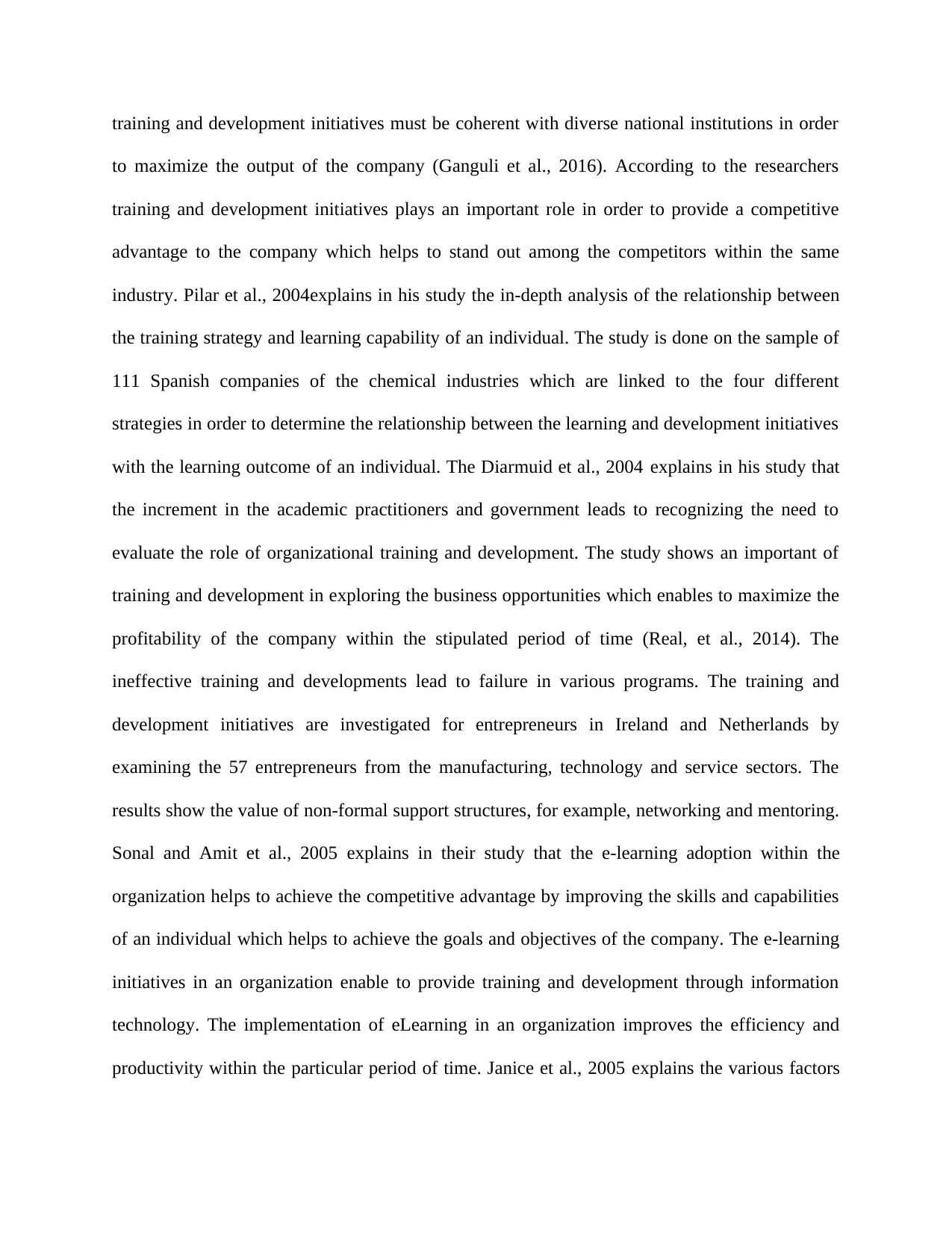
training and development initiatives must be coherent with diverse national institutions in order
to maximize the output of the company (Ganguli et al., 2016). According to the researchers
training and development initiatives plays an important role in order to provide a competitive
advantage to the company which helps to stand out among the competitors within the same
industry. Pilar et al., 2004explains in his study the in-depth analysis of the relationship between
the training strategy and learning capability of an individual. The study is done on the sample of
111 Spanish companies of the chemical industries which are linked to the four different
strategies in order to determine the relationship between the learning and development initiatives
with the learning outcome of an individual. The Diarmuid et al., 2004 explains in his study that
the increment in the academic practitioners and government leads to recognizing the need to
evaluate the role of organizational training and development. The study shows an important of
training and development in exploring the business opportunities which enables to maximize the
profitability of the company within the stipulated period of time (Real, et al., 2014). The
ineffective training and developments lead to failure in various programs. The training and
development initiatives are investigated for entrepreneurs in Ireland and Netherlands by
examining the 57 entrepreneurs from the manufacturing, technology and service sectors. The
results show the value of non-formal support structures, for example, networking and mentoring.
Sonal and Amit et al., 2005 explains in their study that the e-learning adoption within the
organization helps to achieve the competitive advantage by improving the skills and capabilities
of an individual which helps to achieve the goals and objectives of the company. The e-learning
initiatives in an organization enable to provide training and development through information
technology. The implementation of eLearning in an organization improves the efficiency and
productivity within the particular period of time. Janice et al., 2005 explains the various factors
to maximize the output of the company (Ganguli et al., 2016). According to the researchers
training and development initiatives plays an important role in order to provide a competitive
advantage to the company which helps to stand out among the competitors within the same
industry. Pilar et al., 2004explains in his study the in-depth analysis of the relationship between
the training strategy and learning capability of an individual. The study is done on the sample of
111 Spanish companies of the chemical industries which are linked to the four different
strategies in order to determine the relationship between the learning and development initiatives
with the learning outcome of an individual. The Diarmuid et al., 2004 explains in his study that
the increment in the academic practitioners and government leads to recognizing the need to
evaluate the role of organizational training and development. The study shows an important of
training and development in exploring the business opportunities which enables to maximize the
profitability of the company within the stipulated period of time (Real, et al., 2014). The
ineffective training and developments lead to failure in various programs. The training and
development initiatives are investigated for entrepreneurs in Ireland and Netherlands by
examining the 57 entrepreneurs from the manufacturing, technology and service sectors. The
results show the value of non-formal support structures, for example, networking and mentoring.
Sonal and Amit et al., 2005 explains in their study that the e-learning adoption within the
organization helps to achieve the competitive advantage by improving the skills and capabilities
of an individual which helps to achieve the goals and objectives of the company. The e-learning
initiatives in an organization enable to provide training and development through information
technology. The implementation of eLearning in an organization improves the efficiency and
productivity within the particular period of time. Janice et al., 2005 explains the various factors
⊘ This is a preview!⊘
Do you want full access?
Subscribe today to unlock all pages.

Trusted by 1+ million students worldwide
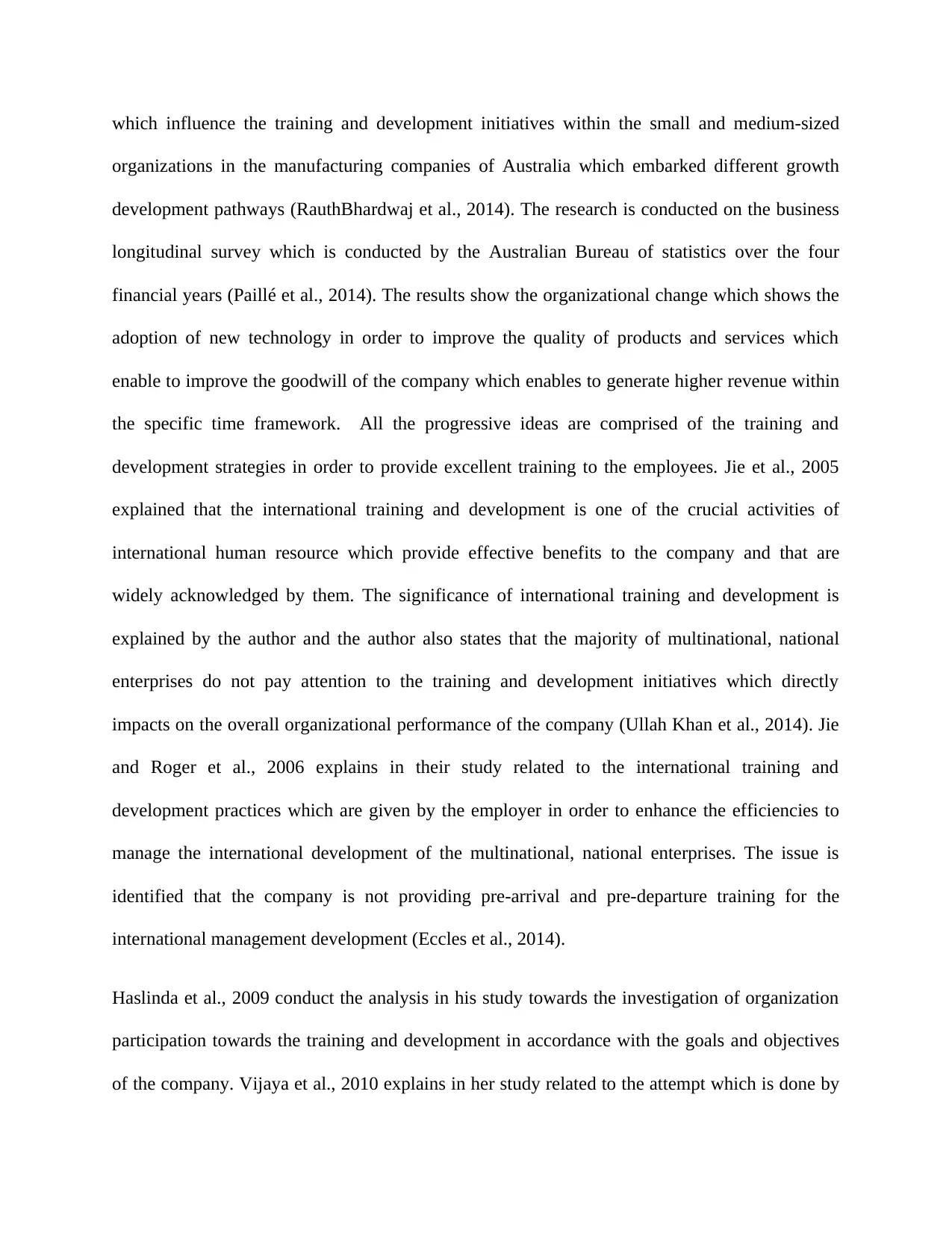
which influence the training and development initiatives within the small and medium-sized
organizations in the manufacturing companies of Australia which embarked different growth
development pathways (RauthBhardwaj et al., 2014). The research is conducted on the business
longitudinal survey which is conducted by the Australian Bureau of statistics over the four
financial years (Paillé et al., 2014). The results show the organizational change which shows the
adoption of new technology in order to improve the quality of products and services which
enable to improve the goodwill of the company which enables to generate higher revenue within
the specific time framework. All the progressive ideas are comprised of the training and
development strategies in order to provide excellent training to the employees. Jie et al., 2005
explained that the international training and development is one of the crucial activities of
international human resource which provide effective benefits to the company and that are
widely acknowledged by them. The significance of international training and development is
explained by the author and the author also states that the majority of multinational, national
enterprises do not pay attention to the training and development initiatives which directly
impacts on the overall organizational performance of the company (Ullah Khan et al., 2014). Jie
and Roger et al., 2006 explains in their study related to the international training and
development practices which are given by the employer in order to enhance the efficiencies to
manage the international development of the multinational, national enterprises. The issue is
identified that the company is not providing pre-arrival and pre-departure training for the
international management development (Eccles et al., 2014).
Haslinda et al., 2009 conduct the analysis in his study towards the investigation of organization
participation towards the training and development in accordance with the goals and objectives
of the company. Vijaya et al., 2010 explains in her study related to the attempt which is done by
organizations in the manufacturing companies of Australia which embarked different growth
development pathways (RauthBhardwaj et al., 2014). The research is conducted on the business
longitudinal survey which is conducted by the Australian Bureau of statistics over the four
financial years (Paillé et al., 2014). The results show the organizational change which shows the
adoption of new technology in order to improve the quality of products and services which
enable to improve the goodwill of the company which enables to generate higher revenue within
the specific time framework. All the progressive ideas are comprised of the training and
development strategies in order to provide excellent training to the employees. Jie et al., 2005
explained that the international training and development is one of the crucial activities of
international human resource which provide effective benefits to the company and that are
widely acknowledged by them. The significance of international training and development is
explained by the author and the author also states that the majority of multinational, national
enterprises do not pay attention to the training and development initiatives which directly
impacts on the overall organizational performance of the company (Ullah Khan et al., 2014). Jie
and Roger et al., 2006 explains in their study related to the international training and
development practices which are given by the employer in order to enhance the efficiencies to
manage the international development of the multinational, national enterprises. The issue is
identified that the company is not providing pre-arrival and pre-departure training for the
international management development (Eccles et al., 2014).
Haslinda et al., 2009 conduct the analysis in his study towards the investigation of organization
participation towards the training and development in accordance with the goals and objectives
of the company. Vijaya et al., 2010 explains in her study related to the attempt which is done by
Paraphrase This Document
Need a fresh take? Get an instant paraphrase of this document with our AI Paraphraser
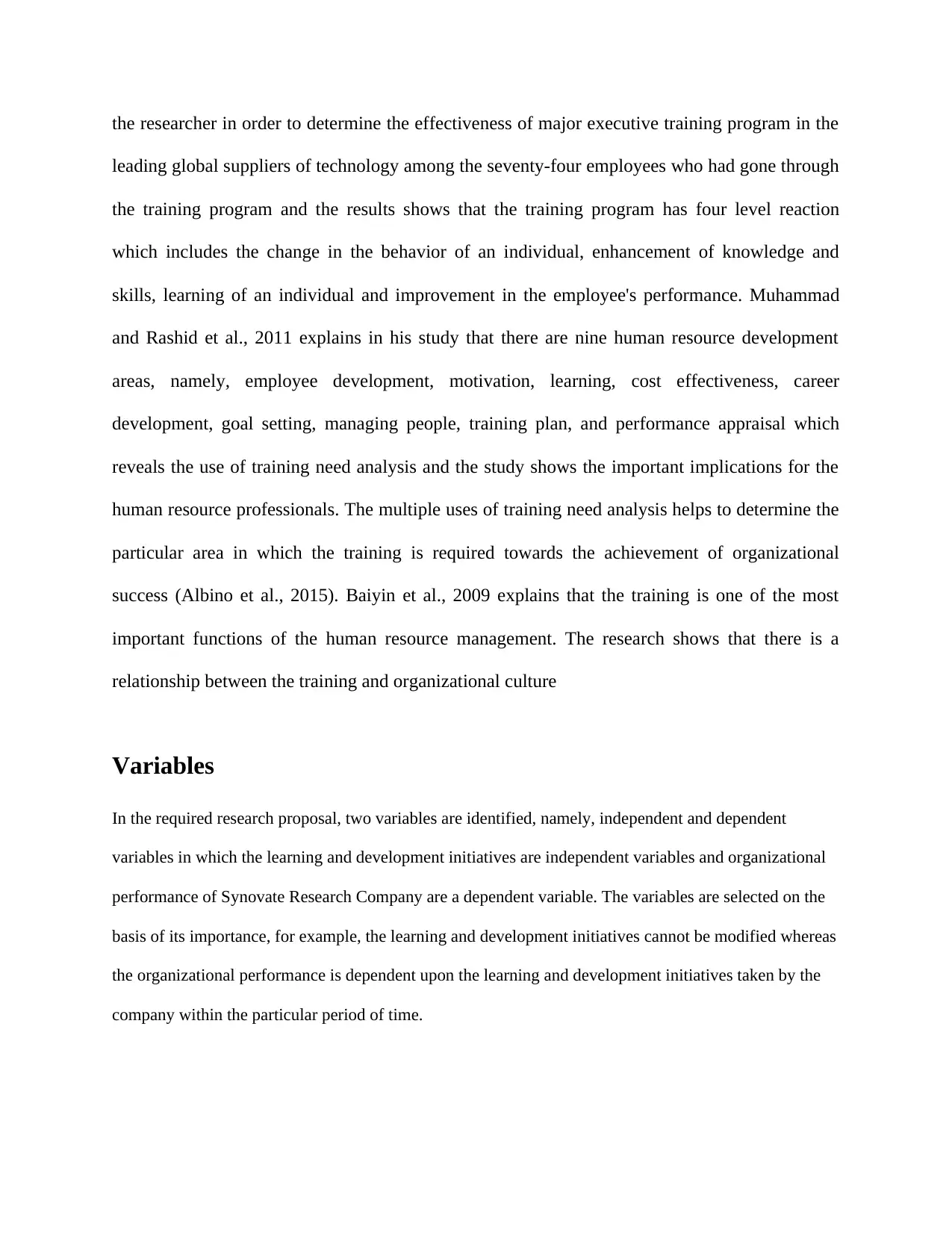
the researcher in order to determine the effectiveness of major executive training program in the
leading global suppliers of technology among the seventy-four employees who had gone through
the training program and the results shows that the training program has four level reaction
which includes the change in the behavior of an individual, enhancement of knowledge and
skills, learning of an individual and improvement in the employee's performance. Muhammad
and Rashid et al., 2011 explains in his study that there are nine human resource development
areas, namely, employee development, motivation, learning, cost effectiveness, career
development, goal setting, managing people, training plan, and performance appraisal which
reveals the use of training need analysis and the study shows the important implications for the
human resource professionals. The multiple uses of training need analysis helps to determine the
particular area in which the training is required towards the achievement of organizational
success (Albino et al., 2015). Baiyin et al., 2009 explains that the training is one of the most
important functions of the human resource management. The research shows that there is a
relationship between the training and organizational culture
Variables
In the required research proposal, two variables are identified, namely, independent and dependent
variables in which the learning and development initiatives are independent variables and organizational
performance of Synovate Research Company are a dependent variable. The variables are selected on the
basis of its importance, for example, the learning and development initiatives cannot be modified whereas
the organizational performance is dependent upon the learning and development initiatives taken by the
company within the particular period of time.
leading global suppliers of technology among the seventy-four employees who had gone through
the training program and the results shows that the training program has four level reaction
which includes the change in the behavior of an individual, enhancement of knowledge and
skills, learning of an individual and improvement in the employee's performance. Muhammad
and Rashid et al., 2011 explains in his study that there are nine human resource development
areas, namely, employee development, motivation, learning, cost effectiveness, career
development, goal setting, managing people, training plan, and performance appraisal which
reveals the use of training need analysis and the study shows the important implications for the
human resource professionals. The multiple uses of training need analysis helps to determine the
particular area in which the training is required towards the achievement of organizational
success (Albino et al., 2015). Baiyin et al., 2009 explains that the training is one of the most
important functions of the human resource management. The research shows that there is a
relationship between the training and organizational culture
Variables
In the required research proposal, two variables are identified, namely, independent and dependent
variables in which the learning and development initiatives are independent variables and organizational
performance of Synovate Research Company are a dependent variable. The variables are selected on the
basis of its importance, for example, the learning and development initiatives cannot be modified whereas
the organizational performance is dependent upon the learning and development initiatives taken by the
company within the particular period of time.
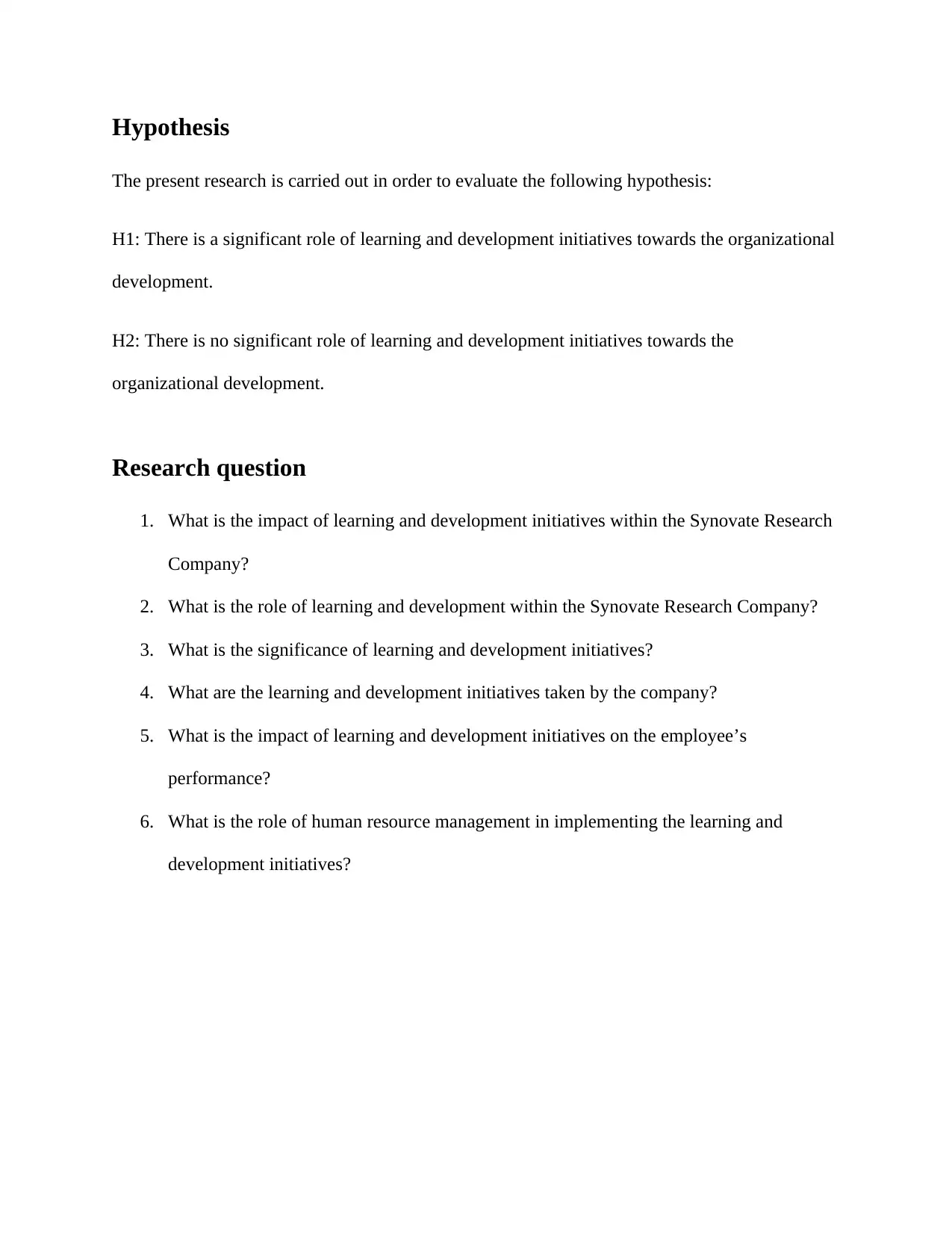
Hypothesis
The present research is carried out in order to evaluate the following hypothesis:
H1: There is a significant role of learning and development initiatives towards the organizational
development.
H2: There is no significant role of learning and development initiatives towards the
organizational development.
Research question
1. What is the impact of learning and development initiatives within the Synovate Research
Company?
2. What is the role of learning and development within the Synovate Research Company?
3. What is the significance of learning and development initiatives?
4. What are the learning and development initiatives taken by the company?
5. What is the impact of learning and development initiatives on the employee’s
performance?
6. What is the role of human resource management in implementing the learning and
development initiatives?
The present research is carried out in order to evaluate the following hypothesis:
H1: There is a significant role of learning and development initiatives towards the organizational
development.
H2: There is no significant role of learning and development initiatives towards the
organizational development.
Research question
1. What is the impact of learning and development initiatives within the Synovate Research
Company?
2. What is the role of learning and development within the Synovate Research Company?
3. What is the significance of learning and development initiatives?
4. What are the learning and development initiatives taken by the company?
5. What is the impact of learning and development initiatives on the employee’s
performance?
6. What is the role of human resource management in implementing the learning and
development initiatives?
⊘ This is a preview!⊘
Do you want full access?
Subscribe today to unlock all pages.

Trusted by 1+ million students worldwide
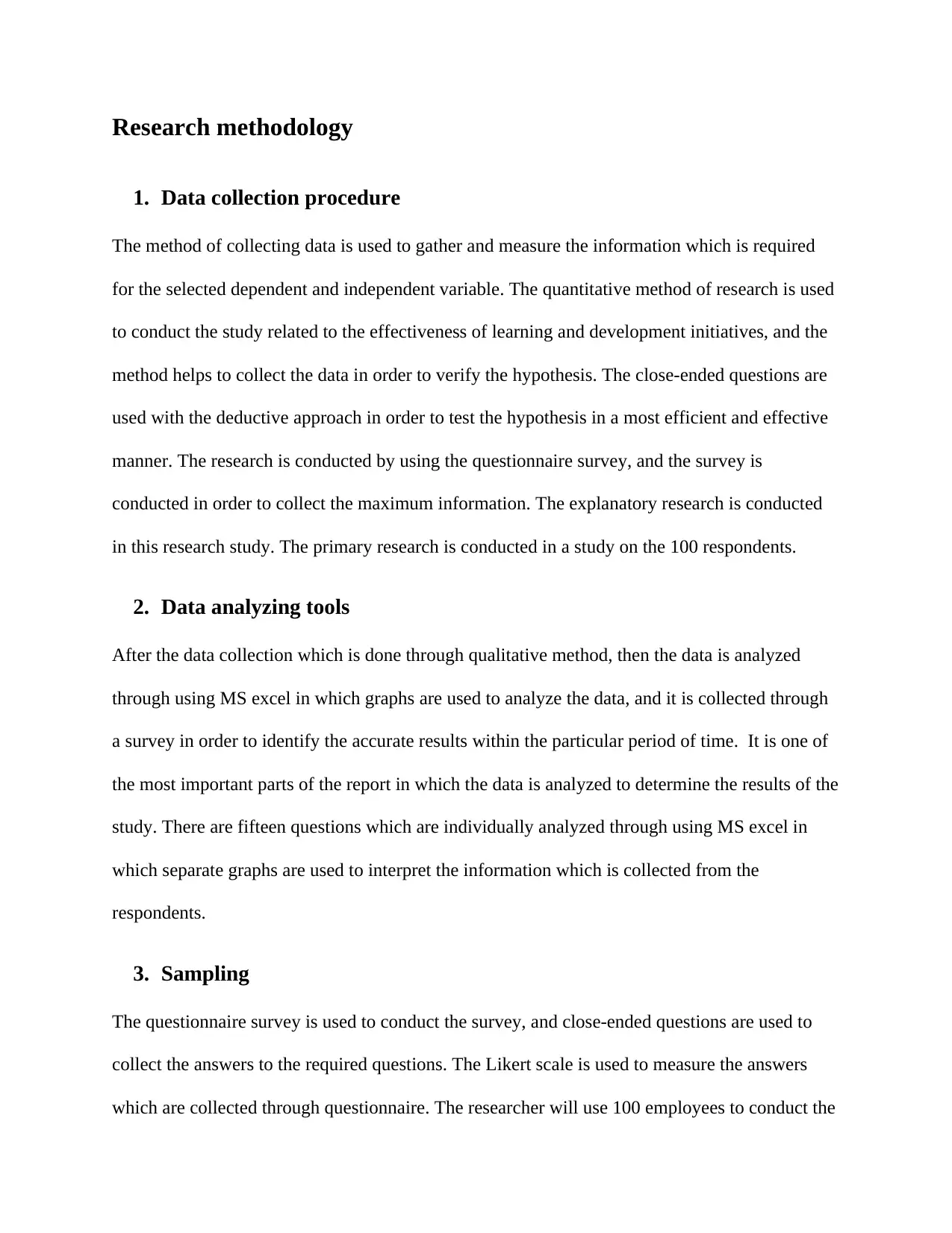
Research methodology
1. Data collection procedure
The method of collecting data is used to gather and measure the information which is required
for the selected dependent and independent variable. The quantitative method of research is used
to conduct the study related to the effectiveness of learning and development initiatives, and the
method helps to collect the data in order to verify the hypothesis. The close-ended questions are
used with the deductive approach in order to test the hypothesis in a most efficient and effective
manner. The research is conducted by using the questionnaire survey, and the survey is
conducted in order to collect the maximum information. The explanatory research is conducted
in this research study. The primary research is conducted in a study on the 100 respondents.
2. Data analyzing tools
After the data collection which is done through qualitative method, then the data is analyzed
through using MS excel in which graphs are used to analyze the data, and it is collected through
a survey in order to identify the accurate results within the particular period of time. It is one of
the most important parts of the report in which the data is analyzed to determine the results of the
study. There are fifteen questions which are individually analyzed through using MS excel in
which separate graphs are used to interpret the information which is collected from the
respondents.
3. Sampling
The questionnaire survey is used to conduct the survey, and close-ended questions are used to
collect the answers to the required questions. The Likert scale is used to measure the answers
which are collected through questionnaire. The researcher will use 100 employees to conduct the
1. Data collection procedure
The method of collecting data is used to gather and measure the information which is required
for the selected dependent and independent variable. The quantitative method of research is used
to conduct the study related to the effectiveness of learning and development initiatives, and the
method helps to collect the data in order to verify the hypothesis. The close-ended questions are
used with the deductive approach in order to test the hypothesis in a most efficient and effective
manner. The research is conducted by using the questionnaire survey, and the survey is
conducted in order to collect the maximum information. The explanatory research is conducted
in this research study. The primary research is conducted in a study on the 100 respondents.
2. Data analyzing tools
After the data collection which is done through qualitative method, then the data is analyzed
through using MS excel in which graphs are used to analyze the data, and it is collected through
a survey in order to identify the accurate results within the particular period of time. It is one of
the most important parts of the report in which the data is analyzed to determine the results of the
study. There are fifteen questions which are individually analyzed through using MS excel in
which separate graphs are used to interpret the information which is collected from the
respondents.
3. Sampling
The questionnaire survey is used to conduct the survey, and close-ended questions are used to
collect the answers to the required questions. The Likert scale is used to measure the answers
which are collected through questionnaire. The researcher will use 100 employees to conduct the
Paraphrase This Document
Need a fresh take? Get an instant paraphrase of this document with our AI Paraphraser
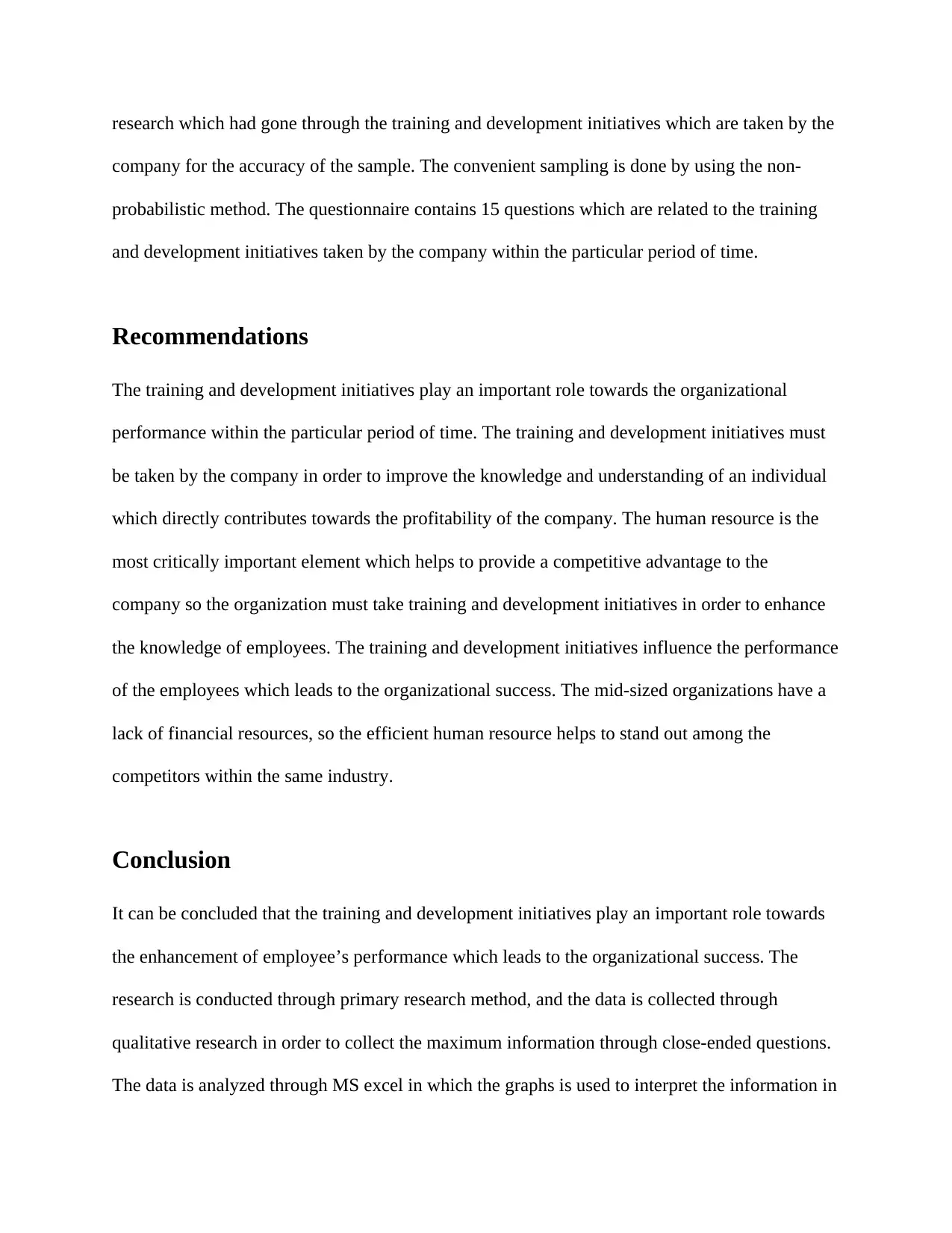
research which had gone through the training and development initiatives which are taken by the
company for the accuracy of the sample. The convenient sampling is done by using the non-
probabilistic method. The questionnaire contains 15 questions which are related to the training
and development initiatives taken by the company within the particular period of time.
Recommendations
The training and development initiatives play an important role towards the organizational
performance within the particular period of time. The training and development initiatives must
be taken by the company in order to improve the knowledge and understanding of an individual
which directly contributes towards the profitability of the company. The human resource is the
most critically important element which helps to provide a competitive advantage to the
company so the organization must take training and development initiatives in order to enhance
the knowledge of employees. The training and development initiatives influence the performance
of the employees which leads to the organizational success. The mid-sized organizations have a
lack of financial resources, so the efficient human resource helps to stand out among the
competitors within the same industry.
Conclusion
It can be concluded that the training and development initiatives play an important role towards
the enhancement of employee’s performance which leads to the organizational success. The
research is conducted through primary research method, and the data is collected through
qualitative research in order to collect the maximum information through close-ended questions.
The data is analyzed through MS excel in which the graphs is used to interpret the information in
company for the accuracy of the sample. The convenient sampling is done by using the non-
probabilistic method. The questionnaire contains 15 questions which are related to the training
and development initiatives taken by the company within the particular period of time.
Recommendations
The training and development initiatives play an important role towards the organizational
performance within the particular period of time. The training and development initiatives must
be taken by the company in order to improve the knowledge and understanding of an individual
which directly contributes towards the profitability of the company. The human resource is the
most critically important element which helps to provide a competitive advantage to the
company so the organization must take training and development initiatives in order to enhance
the knowledge of employees. The training and development initiatives influence the performance
of the employees which leads to the organizational success. The mid-sized organizations have a
lack of financial resources, so the efficient human resource helps to stand out among the
competitors within the same industry.
Conclusion
It can be concluded that the training and development initiatives play an important role towards
the enhancement of employee’s performance which leads to the organizational success. The
research is conducted through primary research method, and the data is collected through
qualitative research in order to collect the maximum information through close-ended questions.
The data is analyzed through MS excel in which the graphs is used to interpret the information in
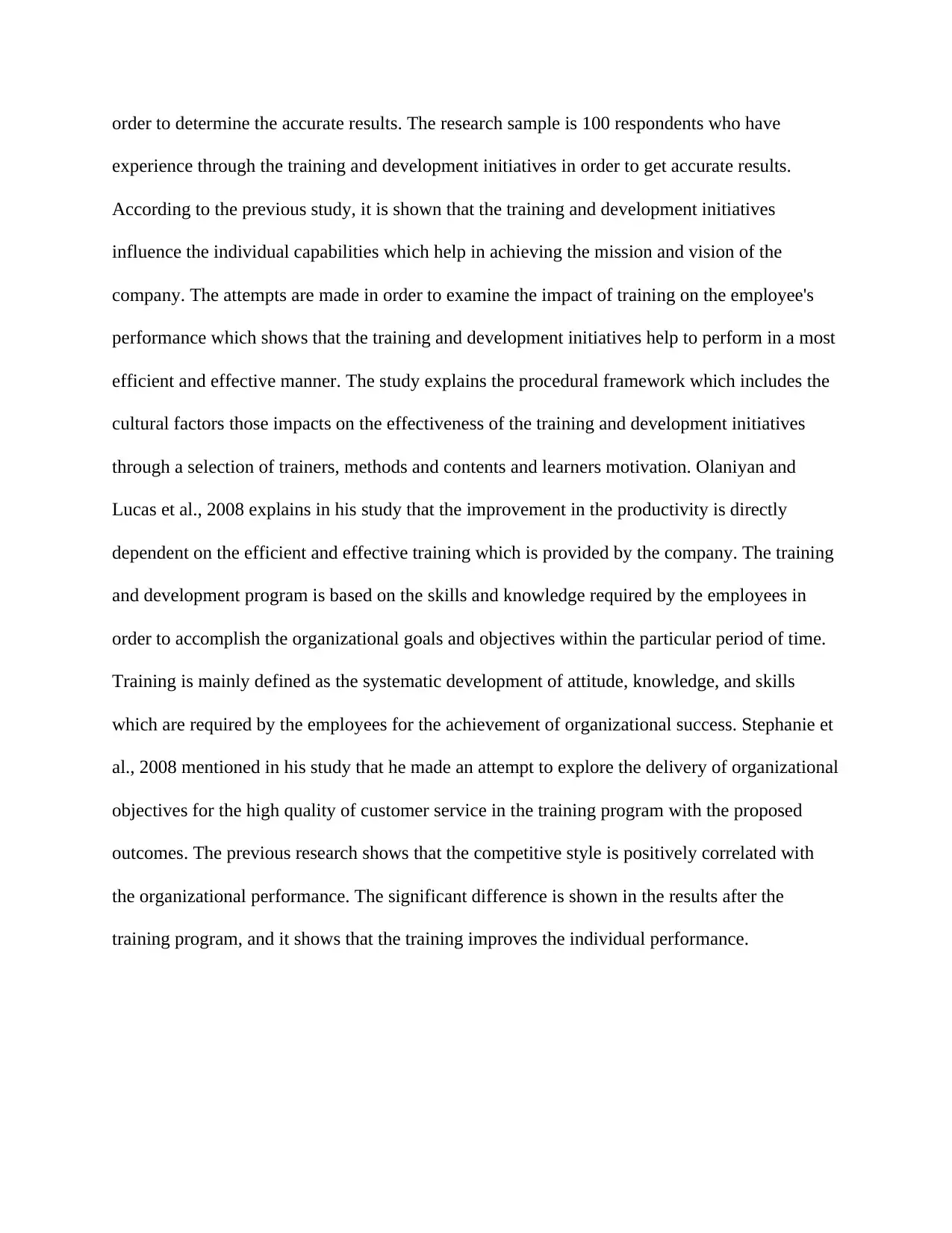
order to determine the accurate results. The research sample is 100 respondents who have
experience through the training and development initiatives in order to get accurate results.
According to the previous study, it is shown that the training and development initiatives
influence the individual capabilities which help in achieving the mission and vision of the
company. The attempts are made in order to examine the impact of training on the employee's
performance which shows that the training and development initiatives help to perform in a most
efficient and effective manner. The study explains the procedural framework which includes the
cultural factors those impacts on the effectiveness of the training and development initiatives
through a selection of trainers, methods and contents and learners motivation. Olaniyan and
Lucas et al., 2008 explains in his study that the improvement in the productivity is directly
dependent on the efficient and effective training which is provided by the company. The training
and development program is based on the skills and knowledge required by the employees in
order to accomplish the organizational goals and objectives within the particular period of time.
Training is mainly defined as the systematic development of attitude, knowledge, and skills
which are required by the employees for the achievement of organizational success. Stephanie et
al., 2008 mentioned in his study that he made an attempt to explore the delivery of organizational
objectives for the high quality of customer service in the training program with the proposed
outcomes. The previous research shows that the competitive style is positively correlated with
the organizational performance. The significant difference is shown in the results after the
training program, and it shows that the training improves the individual performance.
experience through the training and development initiatives in order to get accurate results.
According to the previous study, it is shown that the training and development initiatives
influence the individual capabilities which help in achieving the mission and vision of the
company. The attempts are made in order to examine the impact of training on the employee's
performance which shows that the training and development initiatives help to perform in a most
efficient and effective manner. The study explains the procedural framework which includes the
cultural factors those impacts on the effectiveness of the training and development initiatives
through a selection of trainers, methods and contents and learners motivation. Olaniyan and
Lucas et al., 2008 explains in his study that the improvement in the productivity is directly
dependent on the efficient and effective training which is provided by the company. The training
and development program is based on the skills and knowledge required by the employees in
order to accomplish the organizational goals and objectives within the particular period of time.
Training is mainly defined as the systematic development of attitude, knowledge, and skills
which are required by the employees for the achievement of organizational success. Stephanie et
al., 2008 mentioned in his study that he made an attempt to explore the delivery of organizational
objectives for the high quality of customer service in the training program with the proposed
outcomes. The previous research shows that the competitive style is positively correlated with
the organizational performance. The significant difference is shown in the results after the
training program, and it shows that the training improves the individual performance.
⊘ This is a preview!⊘
Do you want full access?
Subscribe today to unlock all pages.

Trusted by 1+ million students worldwide
1 out of 29
Related Documents
Your All-in-One AI-Powered Toolkit for Academic Success.
+13062052269
info@desklib.com
Available 24*7 on WhatsApp / Email
![[object Object]](/_next/static/media/star-bottom.7253800d.svg)
Unlock your academic potential
Copyright © 2020–2025 A2Z Services. All Rights Reserved. Developed and managed by ZUCOL.





